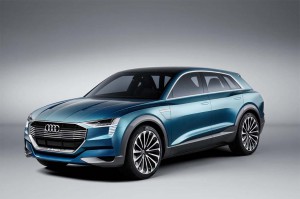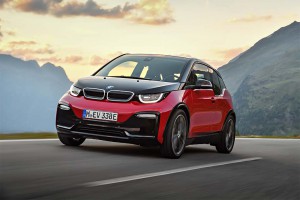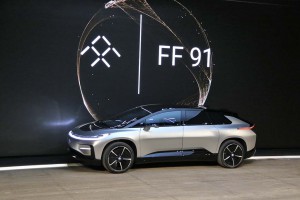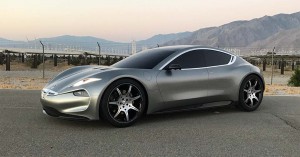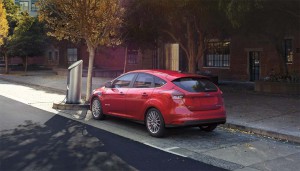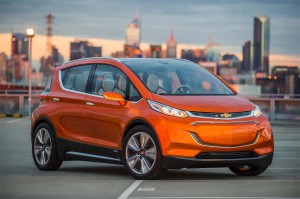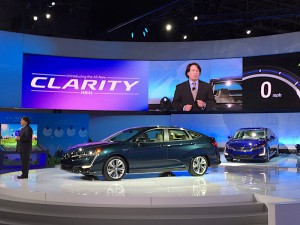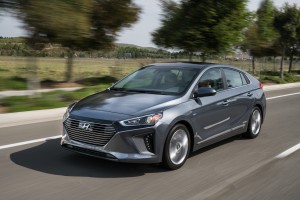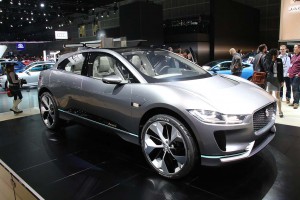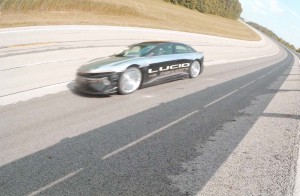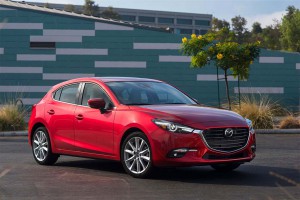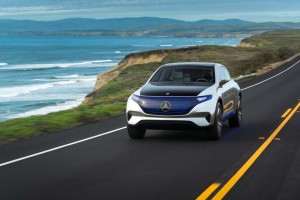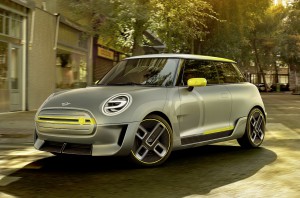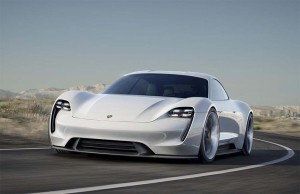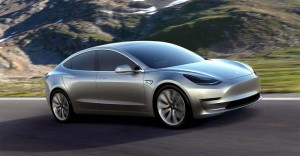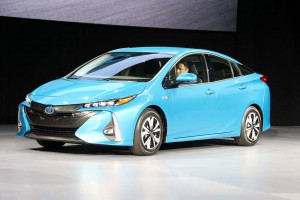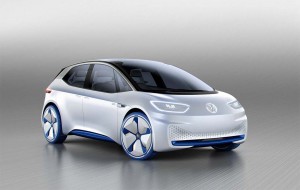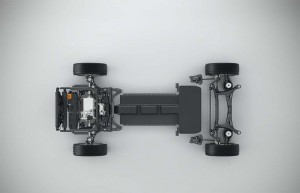With last night’s debut of its second-generation Leaf, Nissan becomes the latest automaker to charge into the long-range battery-electric market.
The 2018 model will travel an estimated 150 miles per charge — or nearly double what the original version of the battery-electric model delivered when it debuted in 2010. Though not quite up to the 200-plus-mile range of the new Tesla Model 3 and Chevrolet Bolt, the new Nissan Leaf is expected to be part of a game-changing trend that will bring a wave of long-range battery cars to market, vehicles that will largely eliminate the concept of “range anxiety” from the vocabulary.
The 2018 Leaf introduces a number of new features, such as its ProPilot Assist system, while keeping the price down at $30,000 – before factoring in federal tax incentives – underscoring another critical trend in the battery-electric market: as battery costs plunge, automakers are bringing more new EVs into mainstream price segments. Add faster charging and the potential appeal of these new models grows exponentially.
While we expect to see hear about a number of other new battery-electric models, here’s a good look at all the offerings we know about coming to market by around 2020:
Aston Martin: The new Aston RapidE definitely won’t fall into the affordable category, this all-electric version of the British marque’s four-door supercar expected to come in at more than $200,000. The RapidE was developed in a joint venture with Chinese-owned LeEco. The alliance has broken down, so production will be limited to 155, but Aston CEO Andy Palmer this week told TheDetroitBureau.com at least one other EV is in the works, and will arrive in showrooms sometime between 2020 and 2022. Our bet is that it will be a version of the new DBX SUV.
(Click Here for more on Aston’s hybrid and EV plans.)
Audi: One of the first luxury automakers to openly commit to going fully electric, Audi’s first BEV is due out in little more than a year and could be called the Q6 e-tron Quattro, basically an all-electric alternative to the familiar Q5. CEO Rupert Stadler now says there will be three BEVs by 2020, possibly a production version of the e-Tron Sportback Concept, and a flagship A9 e-Tron.
(Audi slashes costs to fund $12b electrification program. Click Here for the story.)
BMW: The German maker has been adding a number of hybrids and plug-ins, of late, and offers both the short-range i3 city car and i5 plug-in sports car. CEO Harald Krueger has promised to bring more fully electric models to market and one is expected to be a more stylish city car expected to be called the BMW i5 that will push into the 200-mile range.
(BMW rolling out updated i3 at Frankfurt Motor Show. Click Here for a closer look.)
Faraday Future. This Chinese-funded start-up seemed doomed to vanish when, a month ago, it canceled plans for a $1 billion Nevada assembly plant. But Faraday now has lined up a new plant in California and despite the legion of skeptics says it will still bring the FF91 electric supercar to market by 2018. Look for near-autonomous driving and a price tag that could nudge $200,000.
(Can Faraday Future pull things off with a new plant? Click Here for the story.)
Fisker: Danish designer Henrik Fisker made a splash with the sexy Fisker Karma, but the company quickly went bust. (Sold off to a Chinese firm, it has reappeared as the Karma Revero plug-in). Henrik is setting up a new company and claims he’ll deliver as much as 400 miles range with the new Fisker e-Motion under development. Styling similarities to the old Karma are purely intentional.
(For the latest on plans for the Fisker e-Motion, Click Here.)
Ford: The Blue Oval brand was quick to jump into electrification, though it focused on mostly hybrids and plug-ins, with the all-electric version of its Focus sedan delivering under 100 miles range. Before being ousted in May, CEO Mark Fields promised an array of new battery-based models, including a long-range Volt/Model 3 challenger some believe could be similar in size to the current Ford Escape. Ford also recently launched a joint venture to build EVs in China and that raises the question of whether some of those will come to the U.S.
(Ford launches joint venture to build EVs in China. Click Here for more.)
General Motors: The Detroit automaker scored a coup by delivering its affordable Chevrolet Bolt to market before Tesla could roll out its Model 3. Sales of the 238-mile Bolt have been modest, but GM remains committed to adding still more long-range BEVs, CEO Mary Barra recently revealing that a second electric will be out “before 2020.” Don’t be surprised if it adopts a more SUV-like design. Meanwhile, there are questions about GM’s plans for plug-in models like the slow-selling Chevy Volt which could be pulled from the line-up.
(Chevy Bolt bests Tesla in range test. Click Here for more.)
Honda: The Japanese maker was one of the first to go hybrid, but it’s waffled on all-electric models. Honda is now set to offer three versions of its Clarity platform, the current hydrogen FCV, a plug-in hybrid and a relatively short-range all-electric. CEO Takahiro Hachigo wants two-thirds of Honda’s sales to come from electrified models by 2030, so look for a long-range BEV in the near-term, as well.
(Click Here to check out the Honda CR-V Hybrid debuting in Frankfurt.)
Hyundai: The biggest of the Korean carmakers recently rolled out its triple-threat Ioniq, with hybrid, plug-in and full-electric options, though the EV offers relatively short range. But company officials have broadly hinted that they are working on both a long-range EV, possibly sharing platforms with a new fuel-cell vehicle to replace the current, hydrogen-powered version of the Tucson SUV.
(Hyundai set to expand line-up of eco-friendly models. Click Here for that story.)
Jaguar: Best known for its sleek sports cars and sporty coupes, Jaguar’s best-selling model is now the F-Pace SUV, with a smaller E-Pace soon joining its line-up. So, it’s likely no surprise the British maker decided to go with a ute for its first all-electric model. The I-Pace design reflects the fact that most of its powertrain tech is believe its floor, meaning a compact footprint with a near full-size interior.
(The i-Pace will be just the first step in Jaguar’s electrification plans. Click Here for more.)
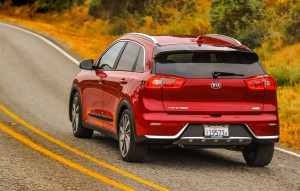
The new Niro Touring Hybrid offers sure footing on the road and off while providing plenty of safety technologies.
Kia: The smaller Korean brand will soon have two versions of its Niro, a hybrid and a plug-in hybrid. It also has the short-range Kia Soul EV. Kia now says it is looking to add an all-electric version of the Niro – which shares platforms with the Hyundai Ioniq. And it will also bring out an all-electric version of the upcoming Stonic crossover expected to deliver range just short of 200 miles.
(For more on the Kia Stonic, Click Here.)
Lucid: Another California-based EV start-up, this company has a number of former Tesla team members developing its Lucid Air supercar. The promise is blinding speed, range of up to 400 miles, near autonomous driving and a design that takes advantage – like Jaguar’s I-Pace – of mounting all the hard bits under the floor, yielding a “business-class” cabin. A 240-mile version will start at around $60,000.
(Is Lucid itself up for sale? Click Here for that story.)
Mazda: The Hiroshima-based automaker doesn’t have a huge R&D budget and has focused on breakthroughs in gasoline power, its new Skyactiv-X engine expected to deliver near-hybrid mileage. But Mazda is about to get into the EV game, this month announcing a partnership with Toyota that will yield new, long-range BEVs produced at an all-new U.S. plant – but production won’t start until 2021.
(For more on the Toyota-Mazda joint venture, Click Here.)
Mercedes-EQ. Yep, the Daimler luxury division is launching a unique marque specifically for plug-based models and it will debut with a production version of the Mercedes-EQ Concept that debuted at last year’s Paris Motor Show. Look for seven or more all-electric models in the coming years, along with an array of plug-in hybrids sold through the Mercedes-Benz brand. We’ll get a hint of another one of those at the Frankfurt Motor Show in the form of the Concept EQ A compact hatchback – which is likely to go into production by 2020.
(Click Here for a look at the Concept EQA.)
Mini. The British brand was one of the first to experiment with an electrified model, albeit one with well under 100 miles range. Finding space for a long-range battery pack in such small cars is a challenge, but Mini is hinting about its future EV direction with the Electric Concept coming to the Frankfurt Motor Show. We’ll have to wait to see how it does on range but Mini promises it will retain the brand’s fun-to-drive dynamics.
(For more on the Mini EV Concept, Click Here.)
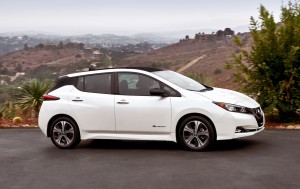
Nissan plans to play up the Leaf's performance capabilities, which are improved over the first-generation model.
Nissan: The second-largest Japanese automaker was the first to deliver a mass production electric vehicle to the market when the original Leaf debuted in 2010. We’re not getting a good luck at the gen-2 model set to roll into showrooms around the world before the end of the year. The new Leaf will boost range to 150 miles and add such tech features as ProPilot Assist and e-Pedal, but the base price will hold at $30,000 — before factoring in federal tax credits.
(For more on the 2018 Nissan Leaf, Click Here.)
Porsche: Best known for its thrilling sports cars, Porsche has also added SUVs and the four-door Panamera in recent years, so why not a high-performance, long-range battery supercar. And the Mission E isn’t likely to be the last foray into pure electrification, as Porsche plans to share platforms and other tech bits with sibling brand Audi, both part of the broad Volkswagen Group.
(Porsche’s performance plans include room for battery power. Click Here for the story.)
Tesla: With nearly 500,000 advance reservations, Tesla aims to prove there’s a true mainstream market for an affordable, long-range BEV. But the Model 3 isn’t the only new product in the upstart maker’s pipeline. CEO Elon Musk has revealed plans for a compact SUV to be called the Model Y, a yet-unnamed electric pickup, and a reborn Tesla Roadster. Production will continue for the Models S and X, as well.
(Tesla cuts prices on its bigger models. Click Here for more.)
Toyota: Its Prius was the world’s first hybrid, but Toyota has been skeptical of lithium batteries, preferring hydrogen power for its Mirai. That’s about to change. Reports say Toyota is working on breakthrough lithium-air batteries that could yield long-range and extremely fast charging. A U.S. factory for battery-car production, part of a joint venture with Mazda, is coming, but won’t open until 2021.
(For more on the Toyota-Mazda joint venture, Click Here.)
Volkswagen: The German maker is de-emphasizing diesels in the wake of its emissions scandal and promises to launch a score of all-electric models within the coming decade. It will start off with a production version of the I.D. Concept that debuted at the Paris Motor Show last year. Look for 200-plus miles of a range and, VW hints, a price tag well below that of the Tesla Model 3 and Chevy Bolt. Meanwhile, VW last month confirmed it is bringing out a m(odern-day version of its classic Microbus – but the I.D. Buzz will be fully electric.
(Click Here for a look at the I.D. Buzz microbus.)
Volvo: The Chinese-owned, Swedish-based Volvo made headlines recently when it announced that all new vehicles debuting in 2018 and beyond will be “electrified.” In reality, most will be conventional hybrids or plug-ins, but expect to see Volvo roll out several all-electric models. That could include a version of the next-gen XC90 or a smaller battery-electric SUV to follow, sources suggest.
(Click Here for the latest on Volvo’s electrification plans.)
This list is subject to revision, as plans are rapidly changing for many automakers. And we’ll have to wait and see which of the many start-ups actually make it into production. The latter list includes NextEV which is working on what could become the world’s fastest production automobile, the 1,360-hp EP9.
Several established automakers are also still working on electrification plans. Fiat Chrysler Automobiles offers the short-range Fiat 500 Electric, and a plug-in version of its new Pacifica minivan. A long-range BEV version may follow.
So, stay plugged in. TheDetroitBureau.com will revise this list as we learn about other electrifying plans.
(To see more about EVs headed to the U.S. in the next few years, Click Here.)
There are plenty of other electric vehicles in U.S. showrooms today, though most, like the current-generation Ford Focus Electric, can manage barely 100 miles per charge. The Mitsubishi MiEV, which will vanish at the end of the 2017 model-year, can only make it 59 miles before having to plug in again, according to the EPA.



